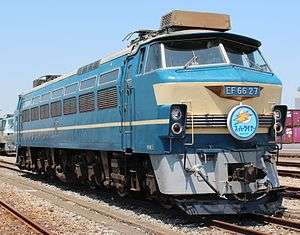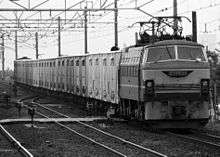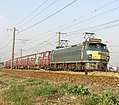JNR Class EF66
The Class EF66 (EF66形) is a six-axle, three-bogied (Bo′Bo′Bo′) DC electric locomotive designed for fast freight used by Japanese National Railways (JNR) and later operated by its descendants JR West and JR Freight.[1] As of 1 April 2016, 39 locomotives remained in service, all operated by JR Freight.[2]
| Class EF66 | |||||||||||||||||||||||||||||||||
|---|---|---|---|---|---|---|---|---|---|---|---|---|---|---|---|---|---|---|---|---|---|---|---|---|---|---|---|---|---|---|---|---|---|
 JR Freight EF66 27 in May 2013 | |||||||||||||||||||||||||||||||||
| |||||||||||||||||||||||||||||||||
| |||||||||||||||||||||||||||||||||
| |||||||||||||||||||||||||||||||||
| |||||||||||||||||||||||||||||||||
Variants
- EF66-900: Prototype locomotive EF66 901, delivered in 1966
- EF66-0: Full-production type (EF66 1 – 55), built 1968 to 1975
- EF66-100: Later type (EF66 101 – 133), built 1989 to 1991
Technical
The locomotives were designed to be able to haul 1,000-tonne trains at 100 km/h (60 mph). Each traction motor has a power output of 650 kW (870 hp), (about 50% more powerful than the Class EF65). The bogies have an air suspension system to limit the impulsive forces on the track.
Operations
During the JNR era, these locomotives were used for freight trains and also for passenger work - primarily hauling night trains such as the Hayabusa sleeping car limited express.[3]
By 1 April 2009, 73 EF66s (including all 33 EF66-100s) were in service, with 63 owned by JR Freight (all based at Suita Depot in Osaka), and 10 owned by JR West (all based at Shimonoseki Depot).[4]
As of 1 April 2016, 39 locomotives remained in service (six EF66-0 and 33 EF66-100 locomotives), all operated by JR Freight.[2]
History
Background

With the opening of the Meishin Expressway between Nagoya and Kobe in 1965 and the Tomei Expressway between Tokyo and Nagoya in 1968, JNR faced increasing competition for freight transport from road hauliers. JNR therefore developed the "10000 series" freight wagons (KoKi 10000 and KoKiFu 10000 container flat wagons, ReSa 10000 and ReMuFu 10000 refrigerated wagons, and WaKi 10000 bogie vans) capable of operating at 100 km/h (60 mph). Express freight services formed of these wagons were introduced on the Tokaido Main Line and Sanyo Main Line from October 1966 using Class EF65-500 electric locomotives built in 1965. These locomotives were designed to be used in pairs hauling 1,000-tonne freight trains, but as pairs of locomotives drew excessive current from the overhead wires, 1,000-tonne freight trains had to be split into 600-tonne and 400-tonne sections when operating on the Sanyo Main Line. This led to the need for a new locomotive design that would be capable of hauling 1,000-tonne trains singly.[5]
Prototype

A prototype locomotive, initially classified EF90 and numbered EF90 1, was built by Kawasaki Sharyo in 1966. It had a total power output of 3.9 MW (5,230 hp), making it the world's most powerful narrow-gauge locomotive at the time.[5]
EF66 901 was retired from service in 1996, and has been stored at Hiroshima Depot since February of 2001, but it was taken apart in March.
Full-production series
The production series of locomotives were delivered from 1968, with 55 built in two batches between 1968 and 1975.[5]
The second batch of locomotives, EF66 21 to EF66 55, delivered between 1973 and 1975, incorporated a number of minor changes and improvements. Most noticeable was the extension of the cab roofs over the windscreens to reduce the deposition of abrasion dust from the pantographs on the windscreens.[5] Some of the first-batch locomotives (EF66 1 to 20) were also subsequently modified with the "sun visor" style cab end roofs.[5]
 First-batch EF66 3 on a freight working in June 1984
First-batch EF66 3 on a freight working in June 1984 First-batch EF66 11 in 2007
First-batch EF66 11 in 2007 Second-batch EF66 49 on a sleeping car service in March 2009
Second-batch EF66 49 on a sleeping car service in March 2009
Post-privatization
Following the privatisation of JNR on 1 April 1987, JR Freight received the prototype (EF66 901) and 39 of the original series (EF66 1 to EF66 39) as well as the Class EF66-100 machines. JR West obtained the remainder of the machines (EF66 40 to EF66 55) - a total of 16.
Shortly after privatization, JR Freight tried out a number of new experimental liveries on its various locomotives, and one Class EF66, locomotive number EF66 20, received an experimental cream and blue livery with large "JR" logos in August 1987. No other members of the class were reliveried, however, and EF66 20 received the new JR Freight two-tone blue livery when it underwent refurbishment in October 1993.[5]
From 1988, JR Freight retrofitted a number of its EF66s (numbers 22 - 24, 26 - 27, 30 - 33, 37) with roof-mounted cab air-conditioning units.[5]
From 1993, JR Freight started refurbishing its fleet of EF66s (numbers 1 - 5, 7 - 10, 11 - 12, 16 - 39, 41, 44, 53, 55). Refurbishment included rewinding of the traction motor coils, removal of the former JNR decorations on the front-end number plates, and repainting into a two-tone blue livery similar to that carried by the EF66-100s.[5] Locomotives refurbished from 2004 onward, however, received a simplified blue livery, similar to the original JNR-style livery.[5]
 EF66 20 in experimental JR Freight livery in the late 1980s
EF66 20 in experimental JR Freight livery in the late 1980s JR Freight EF66 29 in revised livery in June 2003
JR Freight EF66 29 in revised livery in June 2003 JR Freight EF66 28 in February 2007 in the later livery applied to refurbished locomotives
JR Freight EF66 28 in February 2007 in the later livery applied to refurbished locomotives
EF66-100
Due to increased demand, JR Freight began building more EF66s in 1989. This batch of locomotives was classified EF66-100, with locomotive numbered EF66 101 to EF66 133. The Class EF66-100 locomotives were fundamentally the same design as the EF66-0, but with slightly more modern external styling. The driver's cabs are air-conditioned. The Class EF66 100 locomotives were also built in two batches, EF66 101 to 108 and EF66 109 to EF133. The second batch differed in having rectangular headlamps and tail lamps, while the first batch had round lamps.[5]
 First-batch EF66 108 in December 2009
First-batch EF66 108 in December 2009- Second-batch Class EF66-119 in February 2007
Build histories
The individual locomotive build histories are as follows.[5]
| No. | Manufacturer | Date delivered |
|---|---|---|
| EF66-900 | ||
| EF66 901[Note 1] | Kawasaki Sharyo/Kawasaki Electric | September 1966 |
| EF66-0 | ||
| EF66 1 | Kisha Seizo/Toyo Electric | July 1968 |
| EF66 2 | Kisha Seizo/Toyo Electric | August 1968 |
| EF66 3 | Kisha Seizo/Toyo Electric | August 1968 |
| EF66 4 | Kisha Seizo/Toyo Electric | September 1968 |
| EF66 5 | Kisha Seizo/Toyo Electric | September 1968 |
| EF66 6 | Kisha Seizo/Toyo Electric | September 1968 |
| EF66 7 | Kawasaki Sharyo/Kawasaki Electric | July 1968 |
| EF66 8 | Kawasaki Sharyo/Kawasaki Electric | July 1968 |
| EF66 9 | Kawasaki Sharyo/Kawasaki Electric | July 1968 |
| EF66 10 | Kawasaki Sharyo/Kawasaki Electric | August 1968 |
| EF66 11 | Kawasaki Sharyo/Kawasaki Electric | August 1968 |
| EF66 12 | Kawasaki Sharyo/Kawasaki Electric | August 1968 |
| EF66 13 | Kawasaki Sharyo/Kawasaki Electric | August 1968 |
| EF66 14 | Kisha Seizo/Toyo Electric | October 1968 |
| EF66 15 | Kawasaki Heavy Industries/Fuji Electric | September 1968 |
| EF66 16 | Kawasaki Heavy Industries/Fuji Electric | April 1969 |
| EF66 17 | Kawasaki Heavy Industries/Fuji Electric | May 1969 |
| EF66 18 | Kawasaki Heavy Industries/Fuji Electric | September 1969 |
| EF66 19 | Kawasaki Heavy Industries/Fuji Electric | September 1969 |
| EF66 20 | Kawasaki Heavy Industries/Fuji Electric | September 1969 |
| EF66 21 | Kawasaki Heavy Industries/Toyo Electric | August 1973 |
| EF66 22 | Kawasaki Heavy Industries/Toyo Electric | August 1973 |
| EF66 23 | Kawasaki Heavy Industries/Toyo Electric | September 1973 |
| EF66 24 | Kawasaki Heavy Industries/Toyo Electric | September 1973 |
| EF66 25 | Kawasaki Heavy Industries/Toyo Electric | October 1973 |
| EF66 26 | Kawasaki Heavy Industries/Fuji Electric | August 1973 |
| EF66 27 | Kawasaki Heavy Industries/Fuji Electric | August 1973 |
| EF66 28 | Kawasaki Heavy Industries/Fuji Electric | August 1973 |
| EF66 29 | Kawasaki Heavy Industries/Fuji Electric | September 1973 |
| EF66 30 | Kawasaki Heavy Industries/Fuji Electric | September 1973 |
| EF66 31 | Kawasaki Heavy Industries/Fuji Electric | September 1973 |
| EF66 32 | Kawasaki Heavy Industries/Toyo Electric | March 1974 |
| EF66 33 | Kawasaki Heavy Industries/Toyo Electric | March 1974 |
| EF66 34 | Kawasaki Heavy Industries/Toyo Electric | September 1974 |
| EF66 35 | Kawasaki Heavy Industries/Toyo Electric | September 1974 |
| EF66 36 | Kawasaki Heavy Industries/Toyo Electric | September 1974 |
| EF66 37 | Kawasaki Heavy Industries/Toyo Electric | October 1974 |
| EF66 38 | Kawasaki Heavy Industries/Toyo Electric | October 1974 |
| EF66 39 | Kawasaki Heavy Industries/Toyo Electric | November 1974 |
| EF66 40 | Kawasaki Heavy Industries/Toyo Electric | January 1975 |
| EF66 41 | Kawasaki Heavy Industries/Toyo Electric | January 1975 |
| EF66 42 | Kawasaki Heavy Industries/Toyo Electric | February 1975 |
| EF66 43 | Kawasaki Heavy Industries/Toyo Electric | February 1975 |
| EF66 44 | Kawasaki Heavy Industries/Toyo Electric | February 1975 |
| EF66 45 | Kawasaki Heavy Industries/Fuji Electric | August 1974 |
| EF66 46 | Kawasaki Heavy Industries/Fuji Electric | August 1974 |
| EF66 47 | Kawasaki Heavy Industries/Fuji Electric | August 1974 |
| EF66 48 | Kawasaki Heavy Industries/Fuji Electric | September 1974 |
| EF66 49 | Kawasaki Heavy Industries/Fuji Electric | September 1974 |
| EF66 50 | Kawasaki Heavy Industries/Fuji Electric | October 1974 |
| EF66 51 | Kawasaki Heavy Industries/Fuji Electric | January 1975 |
| EF66 52 | Kawasaki Heavy Industries/Fuji Electric | January 1975 |
| EF66 53 | Kawasaki Heavy Industries/Fuji Electric | January 1975 |
| EF66 54 | Kawasaki Heavy Industries/Fuji Electric | February 1975 |
| EF66 55 | Kawasaki Heavy Industries/Fuji Electric | February 1975 |
| EF66-100 | ||
| EF66 101 | Kawasaki Heavy Industries/Toyo Electric | 16 February 1989 |
| EF66 102 | Kawasaki Heavy Industries/Fuji Electric | 25 February 1989 |
| EF66 103 | Kawasaki Heavy Industries/Toyo Electric | 5 March 1989 |
| EF66 104 | Kawasaki Heavy Industries/Fuji Electric | 9 March 1989 |
| EF66 105 | Kawasaki Heavy Industries/Toyo Electric | 13 March 1989 |
| EF66 106 | Kawasaki Heavy Industries/Fuji Electric | 20 March 1989 |
| EF66 107 | Kawasaki Heavy Industries/Toyo Electric | 28 March 1989 |
| EF66 108 | Kawasaki Heavy Industries/Fuji Electric | 31 March 1989 |
| EF66 109 | Kawasaki Heavy Industries/Fuji Electric | 30 January 1990 |
| EF66 110 | Kawasaki Heavy Industries/Toyo Electric | 6 February 1990 |
| EF66 111 | Kawasaki Heavy Industries/Fuji Electric | 12 February 1990 |
| EF66 112 | Kawasaki Heavy Industries/Toyo Electric | 16 February 1990 |
| EF66 113 | Kawasaki Heavy Industries/Fuji Electric | 22 February 1990 |
| EF66 114 | Kawasaki Heavy Industries/Toyo Electric | 2 March 1990 |
| EF66 115 | Kawasaki Heavy Industries/Fuji Electric | 9 March 1990 |
| EF66 116 | Kawasaki Heavy Industries/Toyo Electric | 16 March 1990 |
| EF66 117 | Kawasaki Heavy Industries/Fuji Electric | 29 August 1990 |
| EF66 118 | Kawasaki Heavy Industries/Toyo Electric | 12 September 1990 |
| EF66 119 | Kawasaki Heavy Industries/Fuji Electric | 20 September 1990 |
| EF66 120 | Kawasaki Heavy Industries/Toyo Electric | 28 September 1990 |
| EF66 121 | Kawasaki Heavy Industries/Fuji Electric | 18 October 1990 |
| EF66 122 | Kawasaki Heavy Industries/Toyo Electric | 30 October 1990 |
| EF66 123 | Kawasaki Heavy Industries/Fuji Electric | 13 November 1990 |
| EF66 124 | Kawasaki Heavy Industries/Toyo Electric | 25 February 1991 |
| EF66 125 | Kawasaki Heavy Industries/Fuji Electric | 28 February 1991 |
| EF66 126 | Kawasaki Heavy Industries/Toyo Electric | 8 March 1991 |
| EF66 127 | Kawasaki Heavy Industries/Fuji Electric | 15 March 1991 |
| EF66 128 | Kawasaki Heavy Industries/Toyo Electric | 25 March 1991 |
| EF66 129 | Kawasaki Heavy Industries/Fuji Electric | 13 September 1991 |
| EF66 130 | Kawasaki Heavy Industries/Toyo Electric | 28 September 1991 |
| EF66 131 | Kawasaki Heavy Industries/Fuji Electric | 22 September 1991 |
| EF66 132 | Kawasaki Heavy Industries/Toyo Electric | 24 October 1991 |
| EF66 133 | Kawasaki Heavy Industries/Fuji Electric | 26 September 1991 |
- Notes
- Originally built as EF90 1. Renumbered EF66 901 in August 1968.
Preserved examples
- EF66 1: Stored at Hiroshima Depot in Hiroshima.[6]
- EF66 11: Preserved at The Railway Museum in Saitama.[6]
- EF66 35: Preserved at the Kyoto Railway Museum in Kyoto.[7]
- EF66 45: (No. 1 end cab section) Preserved at a museum located next to Torokko Saga Station in Kyoto.[8]
- EF66 45: (No. 2 end cab section) Preserved outside the Hoshiai Eye Clinic in Midori-ku, Saitama, Saitama Prefecture.[9]
- EF66 49: (No. 1 end cab section) Preserved at a museum located next to Torokko Saga Station in Kyoto.[8]
- EF66 49: (No. 2 end cab section) Preserved at the Pain Aux Seigle bakery in Kizugawa, Kyoto, located near Kizu Station.[10]
 EF66 35 at the Kyoto Railway Museum in October 2016
EF66 35 at the Kyoto Railway Museum in October 2016- The cab end of EF66 45 in Saitama in July 2014
See also
- Japan Railways locomotive numbering and classification
- RENFE Class 251, an electric locomotive type operated by Renfe in Spain based on the EF66[11]
References
| Wikimedia Commons has media related to JNR EF66. |
- Fujii, Katsuhisa (November 1991), 国鉄最大最強力電機EF66形のすべて [All about Class EF66, the largest and the most powerful electric locomotive of JNR], Japan Railfan Magazine, Japan: Koyusha Co., Ltd., vol. 31 no. 367, p. 8 et seq
- Miyahara, Masakazu, ed. (December 2016). 国鉄最終章LAST (鉄道ジャーナル2017年2月号別冊) [JNR - The Final Chapter (Railway Journal February 2017 Extra issue)] (in Japanese). Japan: Railway Journal. p. 23–27. ASIN B01N59AJPB. ISSN 0288-2337.
- "EF66-100". Archived from the original on 27 September 2012. Retrieved 28 January 2009.
- Jēāru zensharyō handobukku: Rail Magazine 2009 JR全車輌ハンドブック2009 [JR Rolling Stock Handbook 2009]. Japan: Neko Publishing. 2009. ISBN 978-4-7770-0836-0.
- Matsuo, Yoshitaka (February 2017). 国鉄最強の電気機関車 EF66 [EF66 - JNR's most powerful electric locomotive]. Rail Magazine (in Japanese). Vol. 34 no. 401. Japan: Neko Publishing Co., Ltd. p. 28–64.
- Sasada, Masahiro (25 November 2014). 国鉄&jr 保存車大全 2015-2016 国鉄&JR保存車大全2015-2016 [JNR & JR Preserved Rolling Stock Complete Guide 2015-2016] (in Japanese). Tokyo, Japan: Ikaros Publications Ltd. p. 122. ISBN 978-4863209282.
- 京都鉄道博物館 [Kyoto Railway Museum]. Japan Railfan Magazine (in Japanese). Vol. 56 no. 662. Japan: Koyusha Co., Ltd. June 2016. p. 47.
- Shimizu, Kaoru (January 2011). 栄光のブルトレ牽引機EF66 45・49 新たなる任務を負って(前編)~嵯峨野への旅~ [Famous Blue Train locomotives EF66 45&49 start new duties (Part 1) The journey to Sagano]. Japan Railfan Magazine. Vol. 51 no. 597. Japan: Koyusha Co., Ltd. pp. 104–107.
- Shimizu, Kaoru (September 2014). 栄光のブルトレ牽引機EF66 45・49 新たなる任務を負って [Famous Blue Train locomotives EF66 45&49 start new duties]. Japan Railfan Magazine. Vol. 54 no. 641. Japan: Koyusha Co., Ltd. pp. 138–139.
- パン屋さんの店頭に49号機! [Loco No. 49 in a Baker's!]. Japan Railfan Magazine. Vol. 51 no. 607. Japan: Koyusha Co., Ltd. November 2011. pp. 104–5.
- Johnston, Howard; Harris, Ken (2005). Jane's Train Recognition Guide. HarperCollins. pp. 95, 344. ISBN 978-0-06-081895-1.